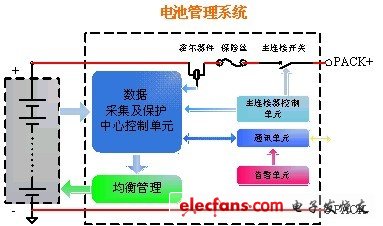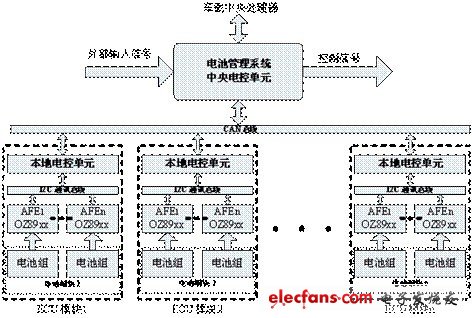1 Design of electric vehicle battery management system
With the shortage of energy, rising oil prices, and increasingly serious urban environmental pollution, the development and utilization of new energy alternatives to oil is increasingly valued by governments of various countries. In the new energy system, the battery system is an indispensable important part. In recent years, electric bicycles, hybrid vehicles, electric vehicles, and fuel cell vehicles powered by lithium batteries have received increasing attention from the market. The application of power batteries in the field of transportation is of great significance for reducing greenhouse gas emissions, reducing air pollution and the application of new energy. Among them, lithium batteries have attracted more and more attention due to their advantages of high energy density, high number of repeated cycles, light weight, and green environmental protection. Therefore, they have been widely used in portable handheld devices such as mobile phones, notebook computers, and power tools. It has begun to enter high-power applications such as electric vehicles and electric vehicles, and has become a hot spot for the development of electric vehicles worldwide.
However, due to abuse conditions such as heating, overcharge / overdischarge current, vibration, and squeezing, the battery life may be shortened and damaged, and even fire, explosion and other events may occur. Therefore, safety issues have become the commercial promotion of power lithium batteries The main constraints. Safe, low-cost, long-life lithium-ion battery safety standards, safety evaluation methods, safety and reliability control of the battery manufacturing process, and the improvement of battery safety and reliability through the optimization of positive and negative electrode materials, electrolytes and separators are the realization of ensuring large-scale power Lithium-ion batteries are safe, reliable, and the key to practical use. As the core component of battery protection and management, the battery management system must not only ensure the safe and reliable use of the battery, but also give full play to the battery's capabilities and extend its service life. As a bridge between the battery and the vehicle management system and the driver, the battery management system It plays an increasingly critical role in the performance of electric vehicles.
2 Main functions of the battery management system
The battery management system is tightly integrated with the electric vehicle's power battery, which constantly detects the battery voltage, current and temperature, and also performs leakage detection, thermal management, battery balance management, alarm reminder, calculation of remaining capacity, discharge power, report SOC & SOH state, according to the voltage, current and temperature of the battery, the maximum output power is controlled by an algorithm to obtain the maximum mileage, and the charger is controlled by the algorithm to charge the best current. Through the CAN bus interface and the vehicle master controller, motor controller, Real-time communication is carried out by energy control system, vehicle display system, etc. Figure 1 is a simple block diagram of a battery management system.

Figure 1 A simple block diagram of the battery management system
Basic functions of the battery management system:
1) Monitor the working condition of single cell, such as single cell voltage, working current, ambient temperature, etc.
2) Protect the battery to avoid battery life shortening and damage under extreme conditions, even explosions, fires and other accidents that endanger personal safety.
Generally speaking, the battery management system must have the following circuit protection functions: over-voltage and under-voltage protection, over-current and short-circuit protection, over-temperature and under-temperature protection, multiple protection for the battery to improve the reliability of the protection and management system (hardware The implementation of the protection has high reliability, the software implementation of the protection has higher flexibility, and the protection of the critical components of the management system fails to provide users with a third level of protection). These functions can meet the needs of most mobile phone batteries, power tools and electric bicycle applications.
3 Electric vehicles pose higher challenges to battery management systems
The electric vehicle battery integration system is an open power system, which communicates through the automotive CAN bus, and works in conjunction with the vehicle management system, charger, and motor controller to meet the car's people-oriented safe driving concept. Therefore, automotive-grade battery management systems must meet: meet the requirements of TS16949 and automotive electronics, achieve high-speed data acquisition and high reliability, automotive-grade CAN bus communication, high resistance to electromagnetic interference (the highest level of EMI / EMC requirements), online Diagnostic function.
Its main functions are:
High-speed collection of information such as battery voltage and temperature; achieving high-efficiency battery balance, giving full play to the capacity of the battery integrated system to increase the life of the battery integrated system, while reducing heat generation;
Estimate and display of battery health and remaining power;
Highly reliable communication protocol (automotive CAN communication network);
Powertrain technology should ensure the battery's safe use, fully utilize the battery's potential, ensure battery performance, and increase battery life;
Battery temperature and heat management are the environmental conditions where the battery system operates at a relatively stable temperature;
Leakage detection and complex ground design.
Since the distribution environment of batteries in electric vehicles is very complex, in the working state of high voltage and high power, the requirements for EMI / EMC are very high, which brings greater challenges to the design of battery management systems.
4 Hierarchical and modular design of electric vehicle battery system
Since the battery system of electric vehicles is integrated by hundreds of battery cells, considering the space, weight distribution and safety requirements of the car, these battery cells are divided into standard battery modules, distributed in different positions of the car chassis , Managed by the powertrain and the central processing unit; each standard battery module is also composed of multiple cells in parallel and series, managed by the module's electronic control unit, and the battery module information is reported to the central processing through the CAN bus After processing the information, the central processor and the powertrain unit report the final information about the integrated system, such as remaining power, health status, and battery capacity, to the vehicle management via CAN bus. system. The hierarchical and modular design of the electric vehicle battery system requires the hierarchical and modular design of the battery management system (Figure 2).

Figure 2 Hierarchical and modular design of electric vehicle battery management system
5 Chip integration technology of battery management system
The reliability requirements of the automotive battery system are extremely high, especially the high-voltage monitoring part and the battery balancing part. Because there are few integrated solutions, many solutions are made of discrete components, resulting in: poor component matching and reduced signal acquisition accuracy; The increase in external nodes makes it difficult to automate tests, increase test costs, reduce test coverage, and have low system reliability; the power consumption of external components is difficult to control; the system size is large and the cost is high.
O2Micro provides the world's first support OZ89xx, a 5-chip series single-chip protection and detection solution, which also supports multi-chip cascade applications. At present, the battery management system solution using the chip has been successfully used in the electric control unit of battery modules for pure electric vehicles and hybrid vehicles.
Table 1 uses standard battery modules as an example to introduce the comparison between discrete and integrated solutions.

It can be seen that the integrated chip solution plays a very important role in improving the reliability of the system and reducing costs, and is the core of hardware design technology in battery integration technology.
6 Conclusion
In the future, power lithium batteries have broad prospects in the field of electric vehicles, and the battery management system will play a key role in the safe use of batteries and communication with vehicle management. Battery management technology includes hardware design technology and software design technology, and high-voltage mixed signal processing technology and chip design are the core of hardware design, which is not only the key to ensuring high reliability, high speed and high precision signal acquisition and processing in the automotive environment, but also The key to improving test coverage, supporting online detection and reducing costs; the core of the software includes battery management algorithms, communication protocol support, and powertrain related technologies. O2Micro is one of the world's leading suppliers of battery management solutions. With its many years of experience in chip design and solution design in battery protection and management, it has mastered the international advanced level of battery management technology and is a global battery manufacturer. System manufacturers provide high-quality technical services and contribute their own strength to the development of electric vehicles in China.
waterproof D-sub system is IP67 rated. These panel-mount connectors are available in solder cup as well as right angle and vertical PCB mount types. The cable-mount connector kit includes the connector, which has solder cup contacts. These connectors are available in 9-, 15-, and 25-positions in Standard Density and 15-, 26-, and 44-positions in high density. The recommended wire gauge for the solder cup connector is 22 AWG to 26 AWG.
These panel-mount waterproof D-subs are designed for rear-mount applications in panels that are up to 2.0 mm thick. They come with two sets of jackscrews. One jackscrew set is 5 mm long for panel thickness up to 1.2 mm, and the other is 6 mm long for panel thicknesses from 1.2 mm to 2.0 mm.
Cable mount D-sub connector kits come with the backshell, seal, thumbscrews, and solder cup connector. They are also easy to install. Simply fit the cable through the backshell, terminate the wire to the solder cup contacts, and hand tighten the cable nut on the rear of the backshell. The backshell will seal a particular range of cable diameters depending on the position count of the connector. Consult the datasheet for specific cable diameter ranges.
Specifications
Current rating
Standard D-sub: 5 A
Hi-density D-sub: 2 A
Breakdown voltage: ≥ AC 500 V/1 minute
Insulation resistance: ≥ 500 MΩ @ DC 500 V
Contact resistance: ≤ 20 mΩ
Material
Contacts: copper alloy, gold-plated
Connector body: nylon 9T or PBT, UL Recognized
Shell: steel, nickel-plated
Applications
DV camcorder
DV VTR
Non-linear editing system
Broadcast monitor
Betacam deck
Panel Mount Waterproof D-Sub Connectors:
Water Proof D-Sub, Standard Density, Male, Panel Mount
Water Proof D-Sub, Standard Density, Female, Panel Mount
Water Proof D-Sub, Standard Density, Female, PCB Mount
Waterproof solder cup, stamped & formed contact D-sub waterproof
solder cup,machined contacts D-sub waterproof
Vertical Mount Waterproof D-Sub Connectors:
Combo Power + Signal D-Sub Connector, Vertical Mount, Pluge Type,
right angle D-sub waterproof
IP67 rated Combo power D-sub waterproof
Waterproof Vertical Mount D-Sub Connectors
Standard Density, Waterproof Vertical Mount D-Sub Connectors, High Density Waterproof Vertical Mount D-Sub Connectors,IP67 D-Sub Connectors Vertical Mount,Board Mount Waterproof Vertical Mount D-Sub Connectors
ShenZhen Antenk Electronics Co,Ltd , https://www.antenk.com